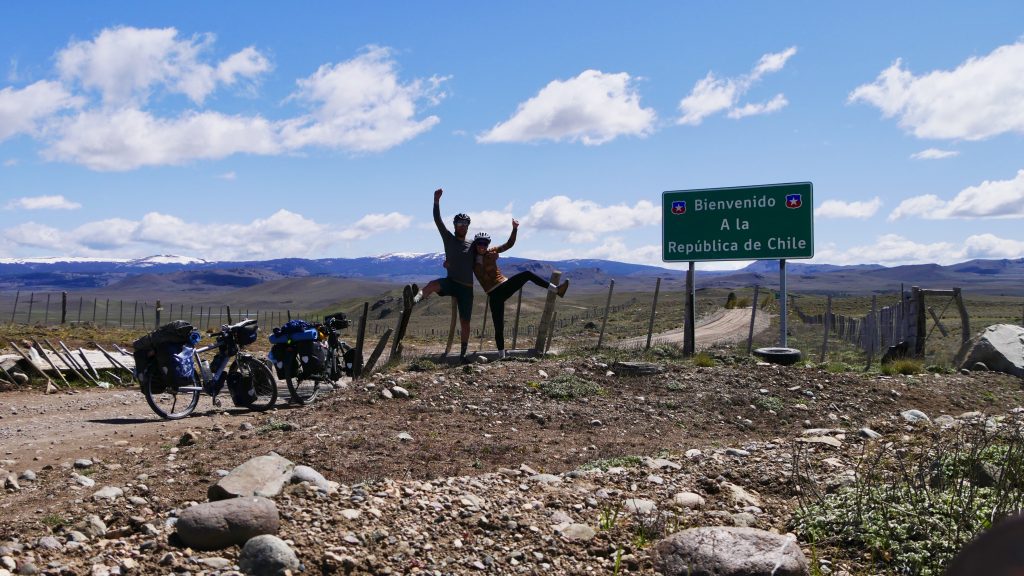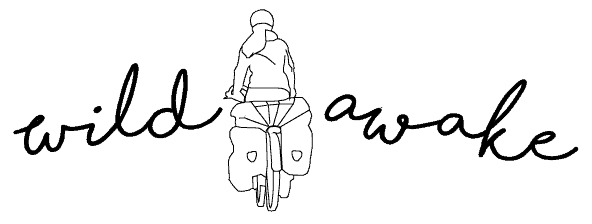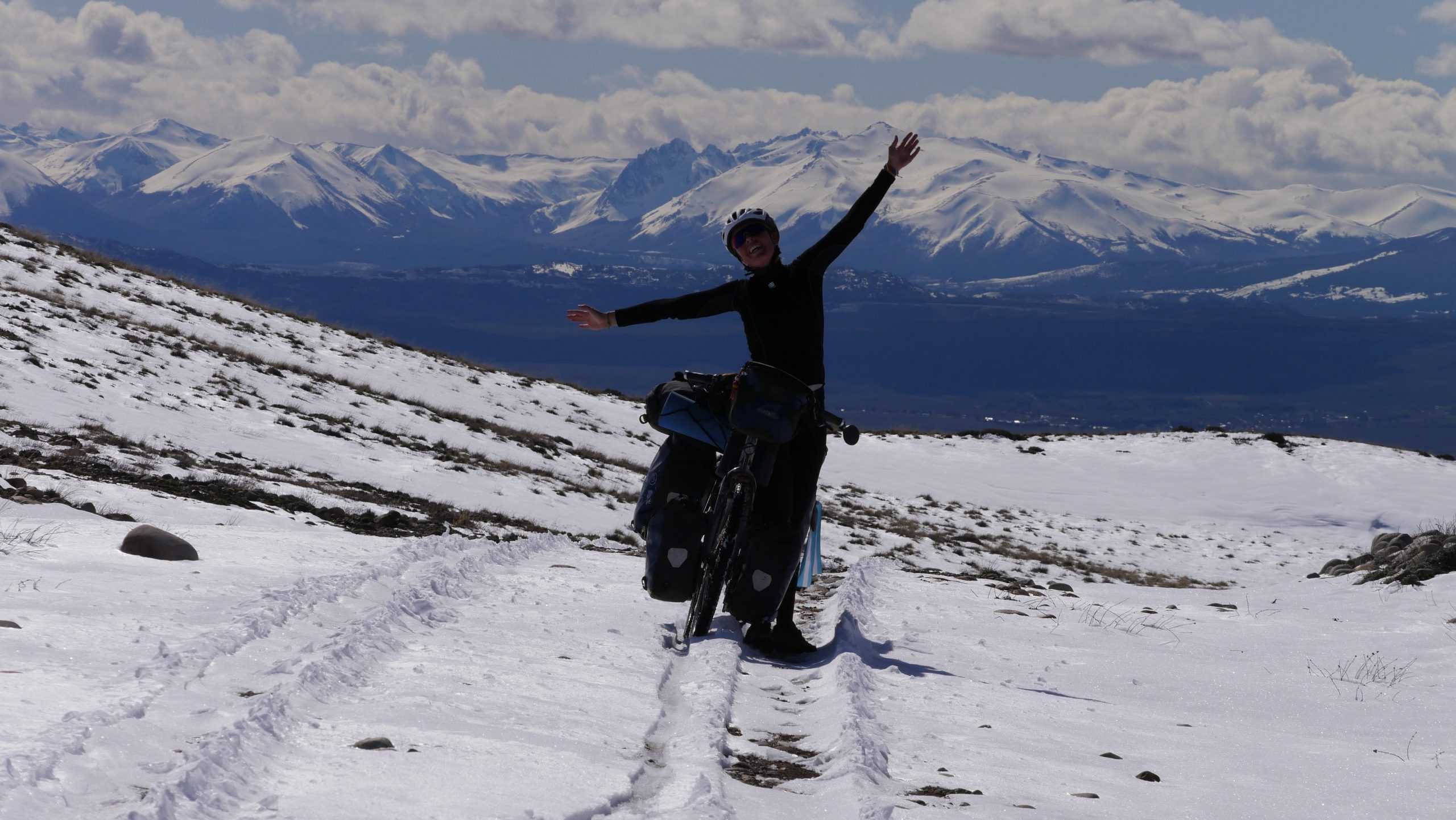
A rough trip
After several days of rest at Rio Pico, while the rain poured down with torrents and the snow fell from the sky with large flakes, Paul and I decided to get back on. The rest days provided time for evaluation of the recent tough cycling days, self-reflection, reflections and deliberation. Are we avoiding the tough routes? What does that mean for the rest of the trip? Does Paul want to give it another chance to see if he can still somehow get pleasure or satisfaction out of these tough cycling days? What are our options for the next several hundred miles? We decide to stick to our initial plan, which consists of several gravel roads, but also with the possibility of deviating somewhere to the paved Ruta 40. The first day will not be too bad and will offer some respite before we really have to get going again. Just 20 km over gravel and then turn right onto Ruta 64 which, although not connecting any major towns, is asphalted. At least, that’s what I saw on a local map of the province. To be sure (because on my paper map this road could not be found at all and on our digital map (OpenStreetMap) it was marked as ‘trail’), we ask again at the local Tourist Information. ‘Yes, paved, look, here it is on the map too.’ That must be over 80 km of brand new asphalt, we conclude, what a wonderful prospect! 600 altitude meters are a piece of cake on a road like that.
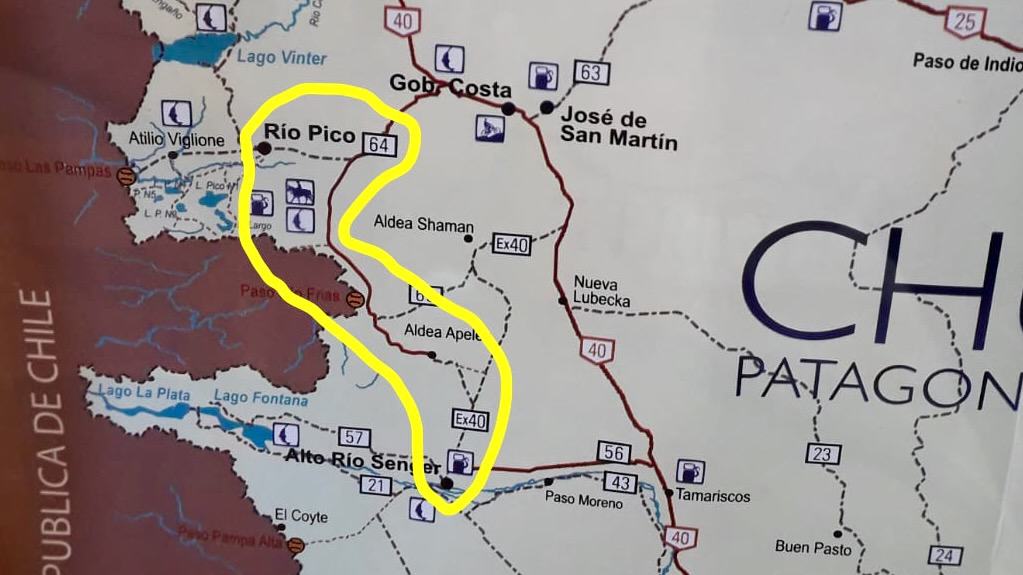
Rested, we roll out of Rio Pico. Against our expectations, not over gravel. Map error. With the wind at our backs we roll 20 kilometers to the exit. A well-spread bed. Only when we are facing it do we see it. We both check the map again. Is it really here? In front of us a narrow gravel path winds between two farms and behind it up the hill as if it leads only to a field. But nothing could be further from the truth. This is the ruta 64 to Aldea Apeleg. I look at Paul who I suspect is attempting to swallow away his frustration and look at this “setback” with new eyes. We decide to push our bikes up the slope which runs along an excavation of pebbles. Maybe the path will get better after that. A little better … enough to bike instead of push. Shall we? We have no idea what awaits us on this route. Still, even Paul finally agrees. We’ll give it a shot!
The trail doesn’t get any better. Most of the altimeters are in the first 30km and so we alternate rolling with stretches where we push the bike. The higher we get, the soggier the ground becomes from the three days of snow and rain. Even on the flat stretches cycling becomes difficult because the wheels sink up to 10 cm into the ground. Paul says nothing more and I trudge along behind him, enjoying the beautiful views while I relax after another 20 meters of lashing the bike. I look behind me and from this side the bushes are all still snow-covered! How nice that looks! From the other side they were green! Oh well, that snowfall … would we notice much of that as we climb higher and higher? That question is answered soon enough when we see the first snowy ground around us. Paul takes a picture of happy me with Giraffe in the snow. A real smile hasn’t come off him for a while. It is time to reconsider. Do we turn around or continue? Back is 8km, through 72. We have climbed a lot, so if it gets more even now, maybe it will be easier?
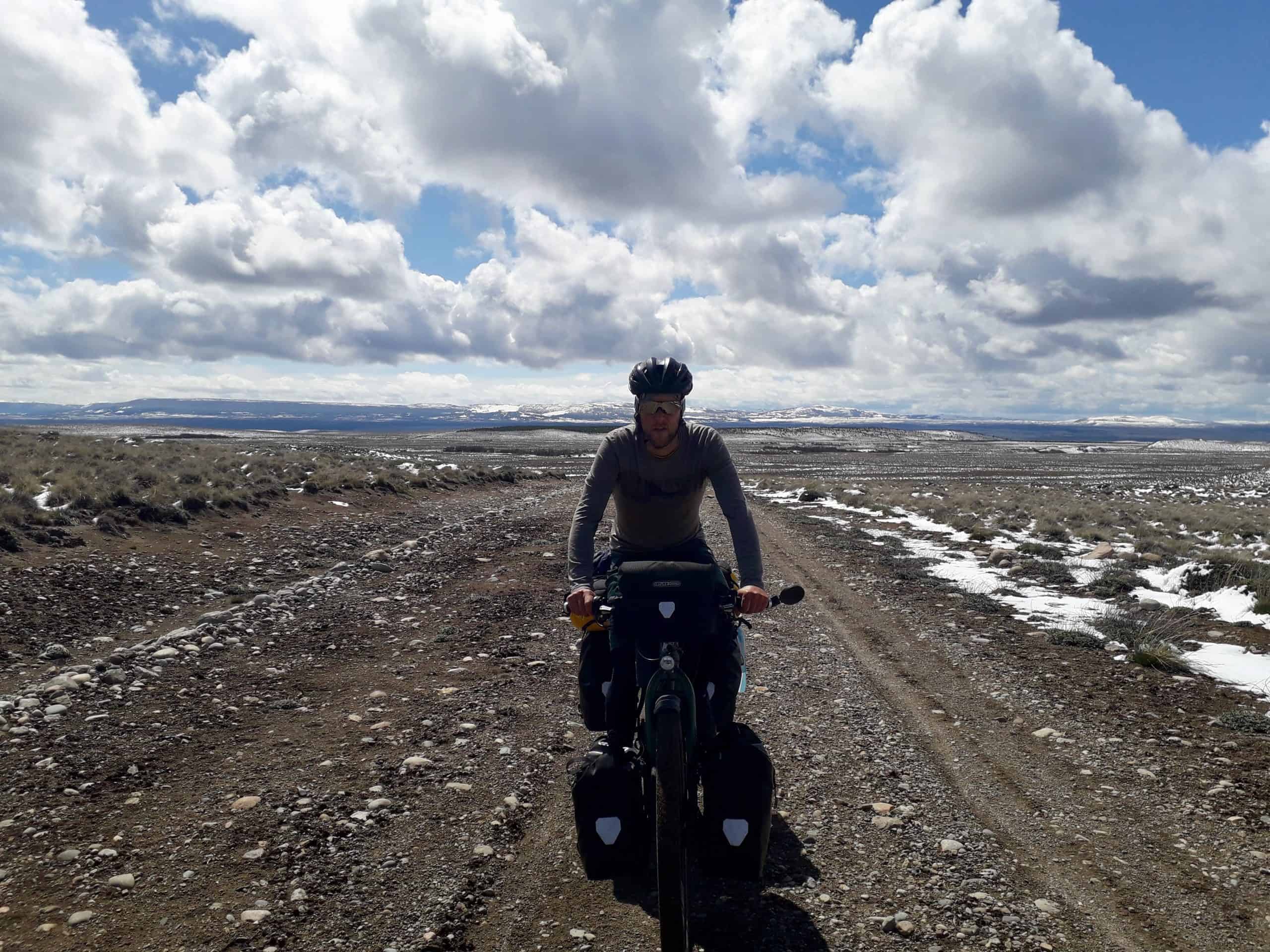

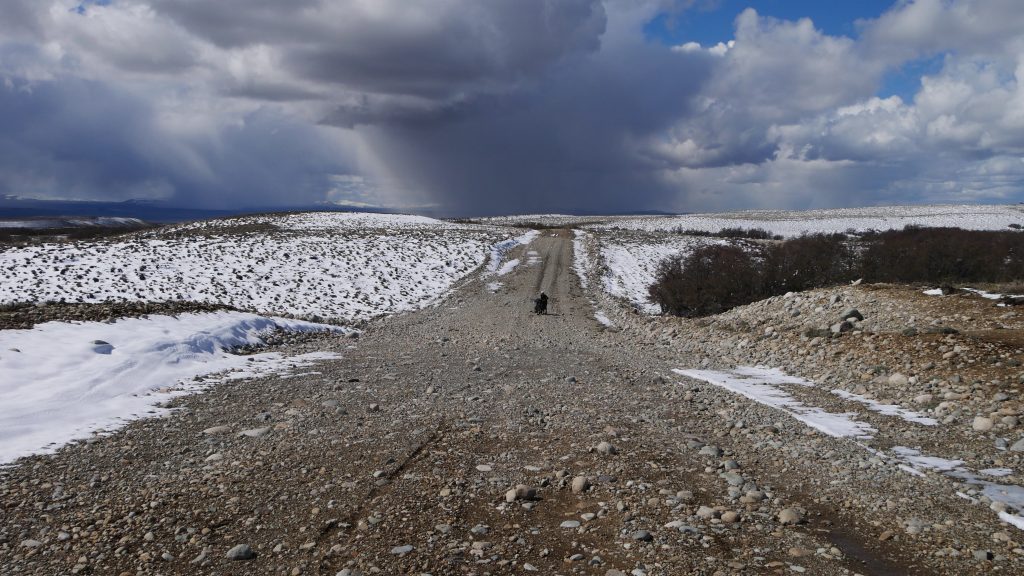
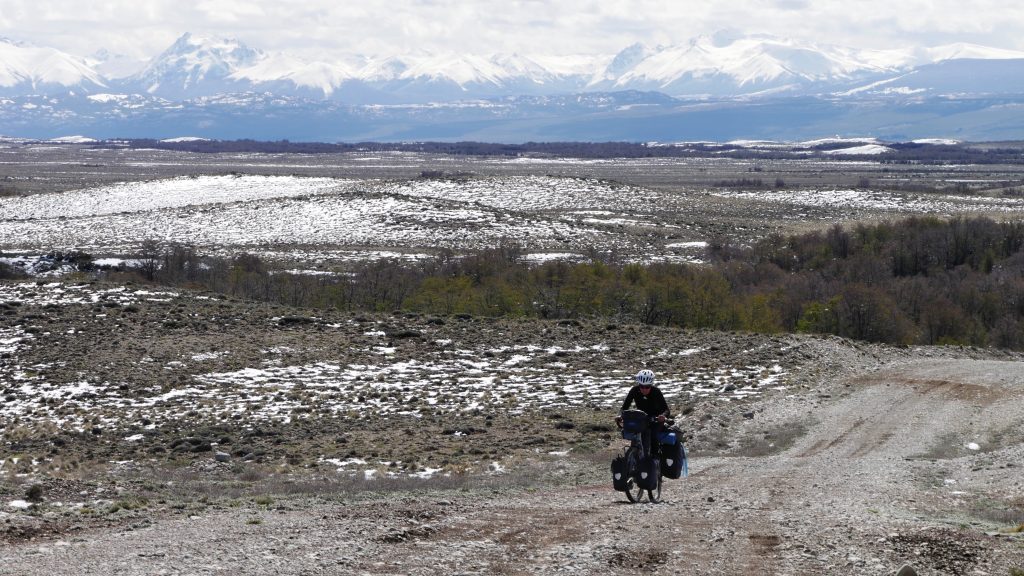
We keep going. We push our bikes through a soggy car track in the snow until that too disappears. The scenery is beautiful! Everything is white and in the distance we can see the high mountains and … rain. We are almost completely surrounded by dark clouds from which we can see the rain falling in the distance. Would it reach us? I don’t think so… or will it? When we reach a plain after 15km, hours of pushing and little bit of rolling, the dark clouds come ominously close. If there’s anything we don’t need right now it’s rain. Besides, we are pretty much out of our futures. We stomp down 9m2 of snow to pitch the tent. Quickly we take off our sweaty clothes and wash ourselves with snow while loudly yelling “oeh” and “aaaaah” (me). Paul wouldn’t be Paul if, despite his frustration about this fiasco, he didn’t set himself up next to the tent to cook a hot meal. The rain stays out and we eat a hot curry in the snow. Far away, or at least it feels that way, from civilization. While Paul, as he says himself, “balances between satisfaction and anxiety,” I build a snowman. When was the last time I did that? The snow is about 30 cm deep and sticks like dough Paul helps me find eyes and a nose. I call him Joop. How much fun is this!!!? I am like a child.
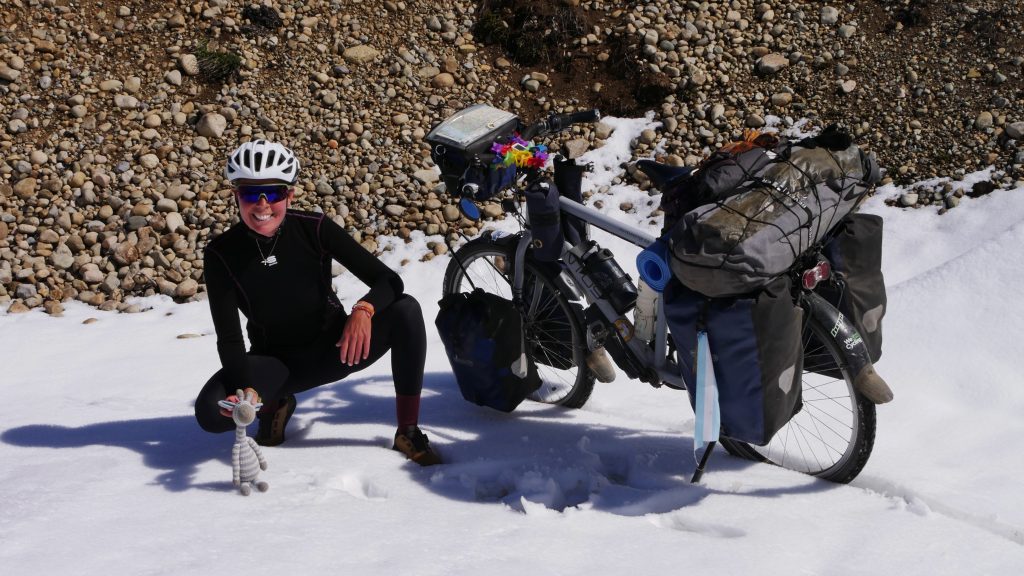
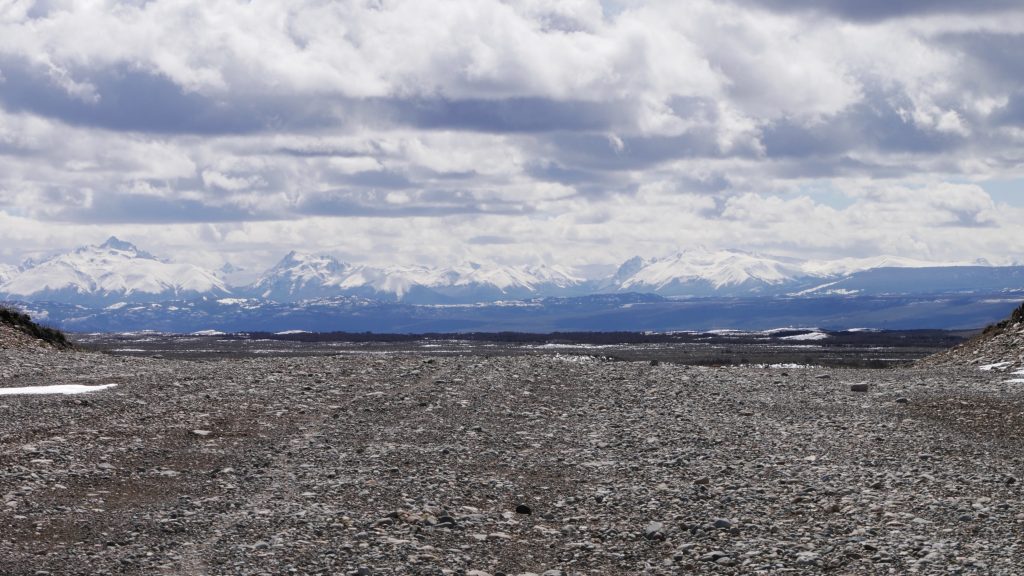
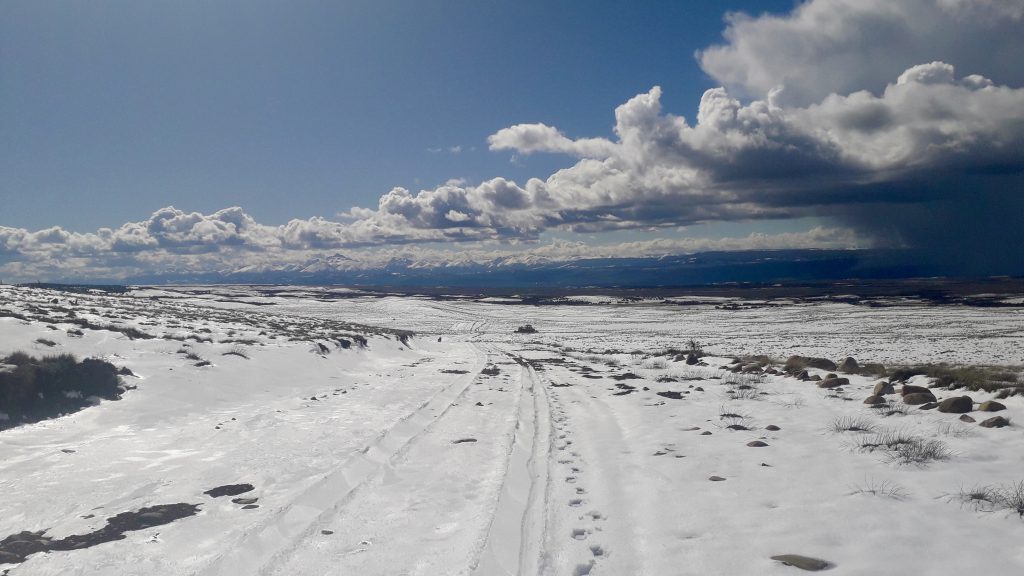


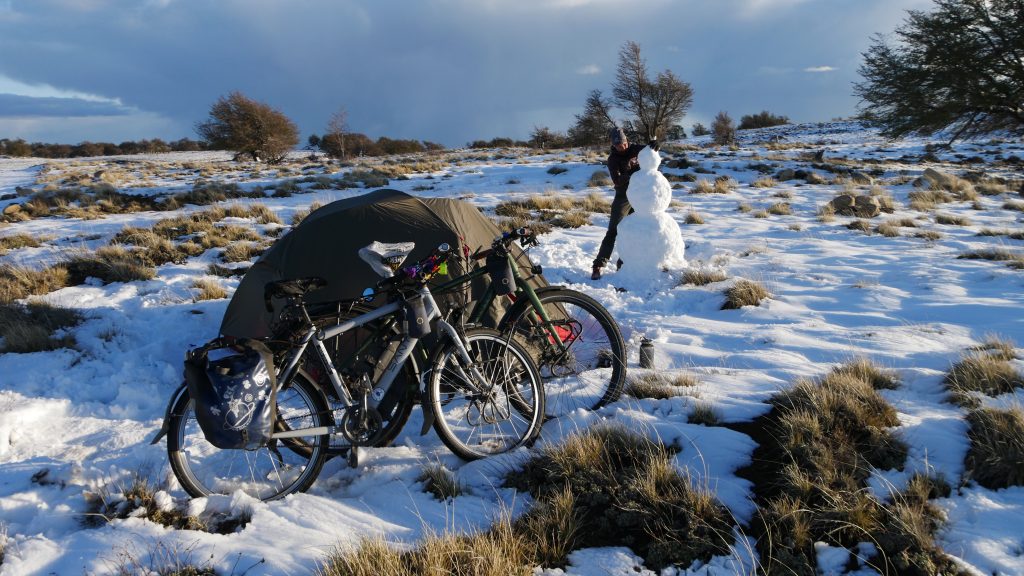
A little later in our warm sleeping bags, we can laugh together for a moment at the idea that this route would be “paved. But Paul also has real concerns. Aren’t we being stupid? Aren’t we taking too many risks? I don’t believe we are. We have few full ‘meals’ with us, but still a full bag of peanuts, raisins, emergency meals, energy bars, peanut butter. We have warm sleeping bags and a waterproof tent and with all this snow there is no shortage of water anyway. The weather is predicted to be good and in the unlikely event that everything turns upside down, we have as an emergency tool the “SPOT,” a device that allows us to call emergency services for a rescue at the push of a button, in case of life-threatening danger. I try to assuage Paul’s concerns with these arguments. The next morning we again decide to move on. For me, because I enjoy this… for Paul, because he wants to take on the challenge.
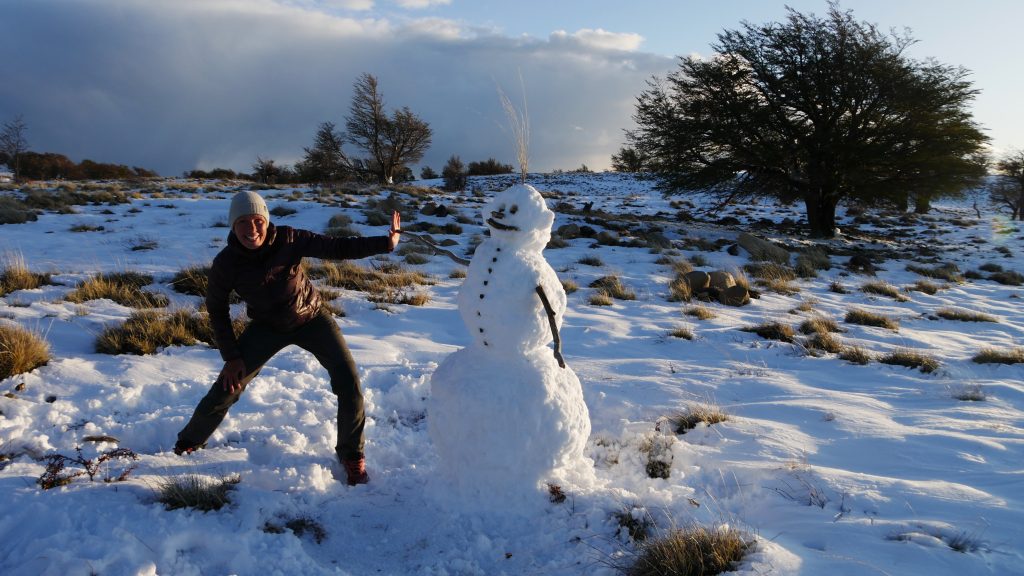

During the days in Rio Pico, I read a book about obsessive-compulsive disorders and the forms of treatment for them. The author himself, 20 years ago, underwent the “flooding” method. In this, the patient was resolutely and completely immersed in that from which his compulsion emanated. The writer had a severe cleaning compulsion and his greatest fear was getting “contaminated” by his own bodily fluids, poop, pee, fill in the blank. His ‘flooding’ thus consisted of completely ‘infecting’ himself and all his ‘safe spaces’ with these. Fill in how… Yes, this was a regular method in a regular clinic at the time.
Because of the rather controversial and shocking nature of this treatment, despite often being successful, another method called “exposure” is now used. Here the patient is exposed in small steps to the situation or object from which his compulsion emanates.
With this info fresh in my brain and conversations with Paul about whether or not to take on the challenge of the ‘hellish gravel roads’ I couldn’t resist telling him about these methods. In fact, we had planned to try to see through ‘exposure’ if Paul could make friends with the bad gravel roads. But unintentionally this became a matter of merciless ‘flooding’. Unplanned, we have the toughest route (for us) to tackle. Now let’s hope this has as positive an effect on Paul as it did on the author of the book… Together we can laugh quite a bit at this comparison.

Contrary to our hopes, it takes a long time before we are no longer slogging through the deep snow. But when we finally get rid of it, the next challenge presents itself. 7km from our camping spot is a river. We knew this was a risk. Would there be a bridge? There is! But before we can cross that bridge, we have to wade through the river where it has swept away a good chunk of the road. On sandals we wade through the ice-cold water. I can’t understand how Paul can’t enjoy this. Am I crazy?
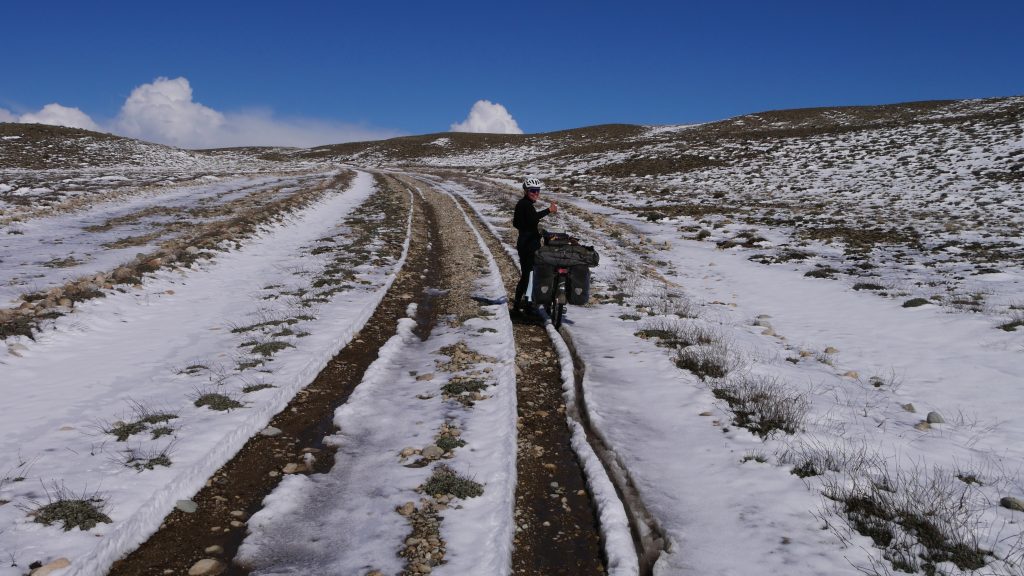
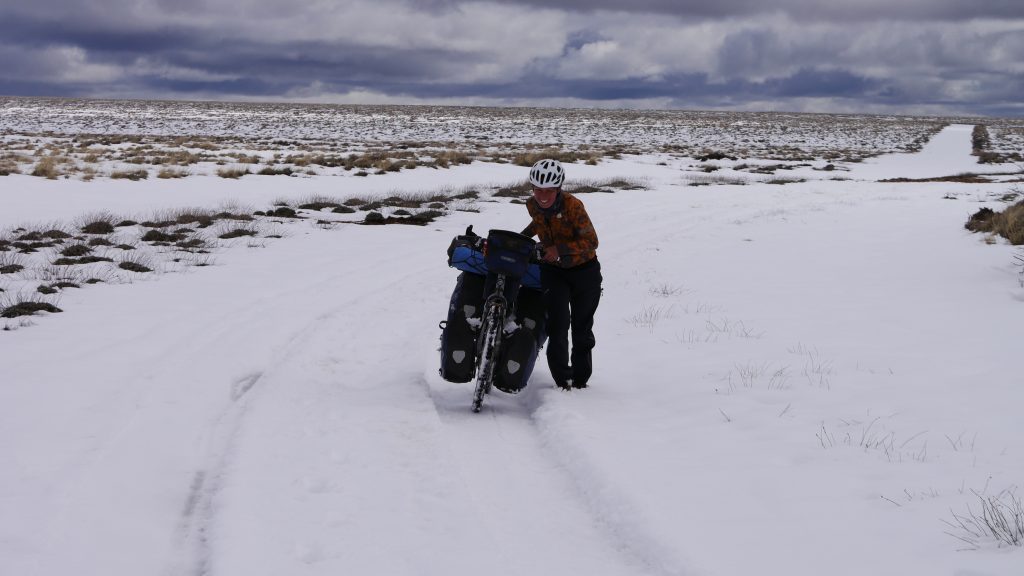

‘The sheep are over the dam’ as we say in Holland. Now that we have crossed this river we are not going back, despite the long road ahead. Much of the time Paul and I are each fighting our own battle with the “road. Over lunch we catch up on how things are going, how it feels, how it’s between our ears. Even though Paul himself sees that the fears he has are not necessarily real, they still get in the way of his enjoyment. I feel guilty for having “dragged” him along this route. I want him to have fun, too. ‘Also,’ because even though it is leaden, I am enjoying this harsh trek.
After the first river ford, about 10 more streams follow. These have no bridge at all. They are too deep to cycle through because it has rained and snowed a lot and this ‘road’ was never meant to be traveled with anything but a 4×4 pickup truck. I can see from Paul that his confidence, or surrender, is growing as he takes off his shoes and rolls up pipes as a matter of course at yet another small river. We are going to make it.

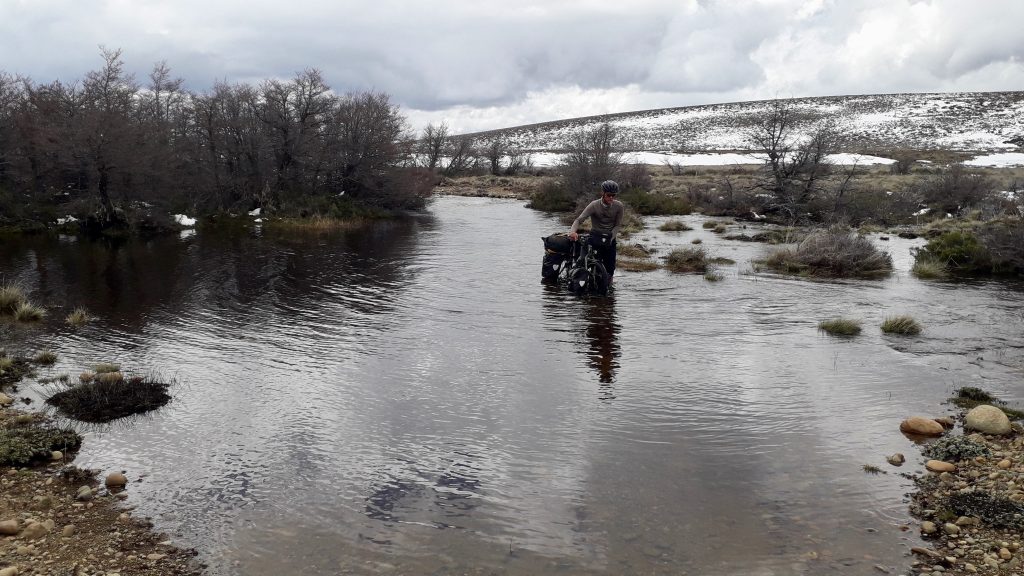
The second day we cover 28km. We camp next to the trail and I even manage to start a fire. This is just as well because our fuel (gasoline) has run out and it looks like we will be eating cold. Fortunately, we have a pan with us that we can put in the campfire and so the pasta is cooking surprisingly quickly after all. We both enjoy these little inventive solutions.
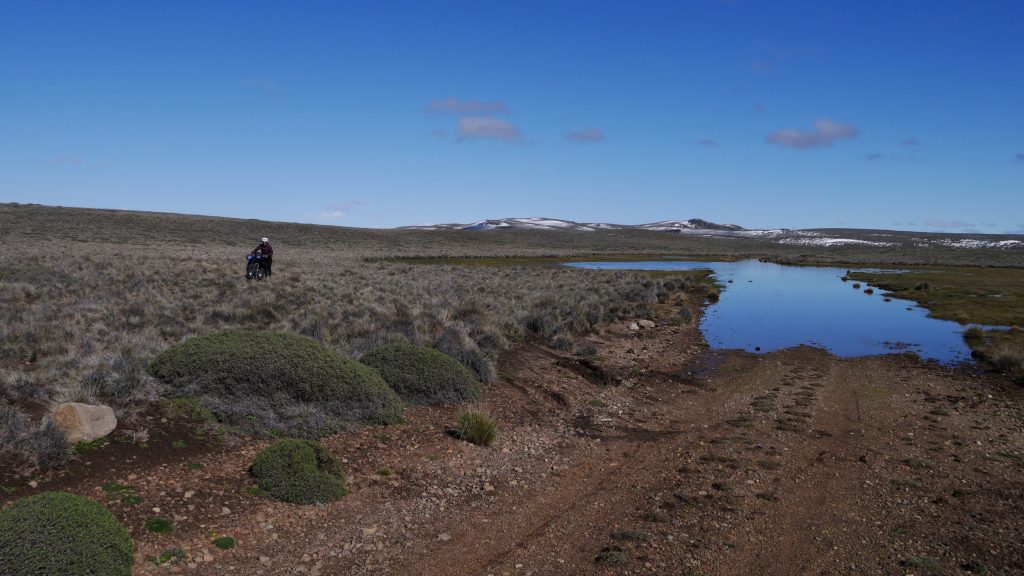
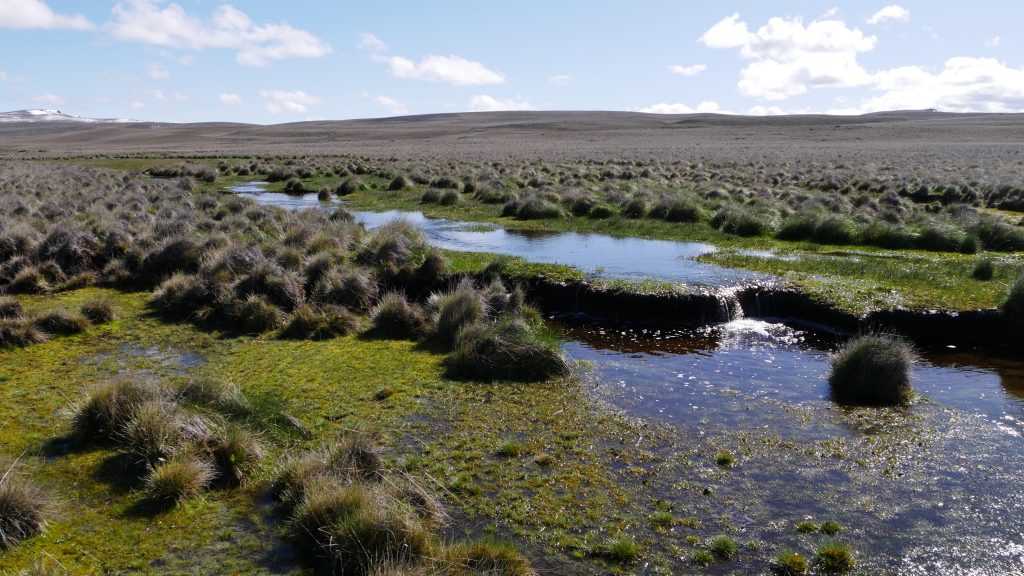
The third day the path changes temporarily into a stream, but the moment comes when the ground under our wheels becomes solid again and we can really cycle. When a small road from Chile arrives, the road surface even changes to solid earth and the last stretch we roll like victors towards Aldea Apeleg. A village of nothing … We buy some fried sandwiches in the only store. It is not attractive to camp here.
It is still fairly early in the day, so we decide to take the gravel road to Alto Rio Senguer. A dead straight gravel road. The wind blows with full force at our backs. This could be a piece of cake, were it not for the fact that the road surface is full of pebbles and consists entirely of washboard … that’s a surface exactly as you expect by that term, caused by speeding cars. The surroundings are… bare, empty, nothing. This is not where we are going to camp. We set our minds to zero and look at 48km and drive. The past few days are taking their toll and my neck and back hurt. The strength is gone and with every bump my aching bones and muscles are shaken like a sack of potatoes. This time I’m the one complaining. It’s not going…just, not…just. We reach Alto Rio Senguer and check into a little hotel. A bed, a shower, heating. We’re absolutely knackered.
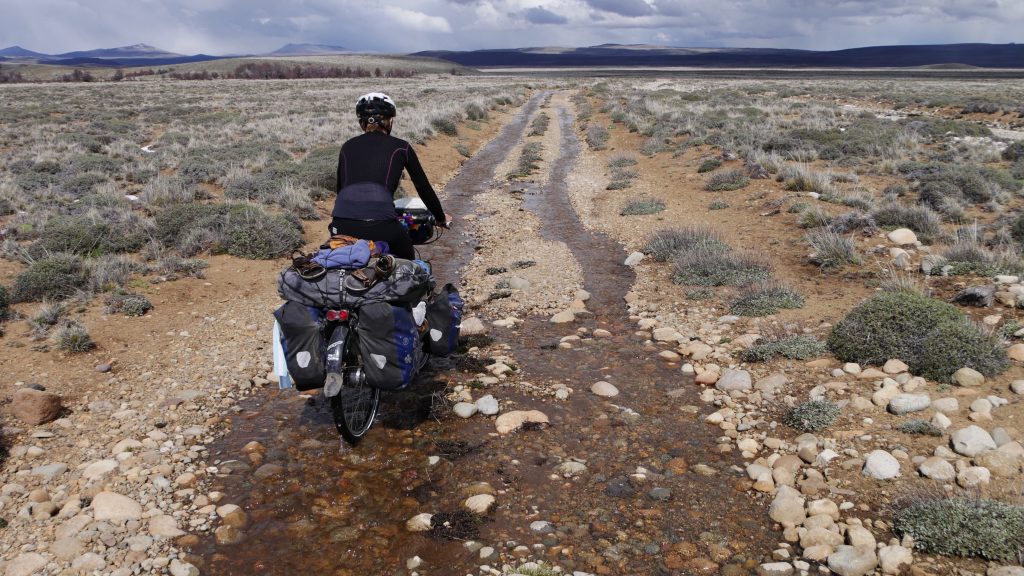


At the bakery/mini-market we stocked up for the evening planning not to leave our room for the rest of the evening. In bed we ‘smaus, as I call it. Sandwiches, olives, pieces of cheese, tomato and my favorite Argentine sweet treat ‘alfagores’: two round cookies with ‘dulche de leche’ (kind of caramel spread) encased in dark chocolate in between. We are proud of each other. Paul of me for continuing to enjoy the trek despite the harsh conditions. And I am proud of him because he dared to do it, persevered and can almost look back with a smile. The next day we have a rest day.
In the village, we find a tiny take-out place for pizza and sandwiches run by an old lady of 1.40m. We ask her if we can come for dinner around 6:00 pm. A vegetarian pizza, is that possible? She carefully writes down all the ingredients we discover together in the refrigerator. That will be delicious! When we are back at her door at 6:00 p.m. sharp, the woman has set the only table in the room for us and put two chairs at it. She apologizes for not having any drinks for sale. No one ever actually eats there, she says. She serves a carafe of water and a moment later she comes in glowing with a double-topped large pizza. We can only eat half; we pack the other half for lunch the next day. Before we leave, the woman beckons us over to the freezer and shows us what self-made ingredients she has added. Green beans and Chinese cabbage. She is delighted that we enjoyed it so much, as are we!

From Alto Rio Singuer, our route leads to the Chilean border. Here we will continue our trek via the legendary “Carretera Austral. It is 2 days of cycling to the border. As we buck against the wind again towards the end of the first day on a rough gravel road, we decide to give a thumbs up when a pickup truck arrives. The driver, an Australian living in Uruguay who advises farmers on holistic sheep keeping, drives himself to the border village and we are welcome to ride with him as far as there. Eagerly we accept his offer, knowing that we will otherwise be boxing up a full day tomorrow against the wind. At the border, we spend the night in a tiny home(ly) hotel.
We are now at the border earlier than planned. We had not counted on this in terms of food. That is, we have too much food. Chile has the strictest food import rules I have ever encountered at a border. No vegetables, fruit, honey, animal products, nuts, seeds… and basically nothing with opened packaging. Sitting on the bed in our tiny room, it’s back to ‘smausen’. Paul eats a bag of peanuts, the cheese goes on the bread in thick slices with 3 mm of butter underneath. In the morning we eat the best stuffed oatmeal breakfast ever prepared. A precious bag of red lentils and a few more wares we gift the hostess. I hide Paul’s extensive herb collection at the bottom of my sleeping bag. I know from experience that the (usually male) customs officers never look beyond what is on top of the bicycle bag, especially in the case of a woman. I trust this experience.
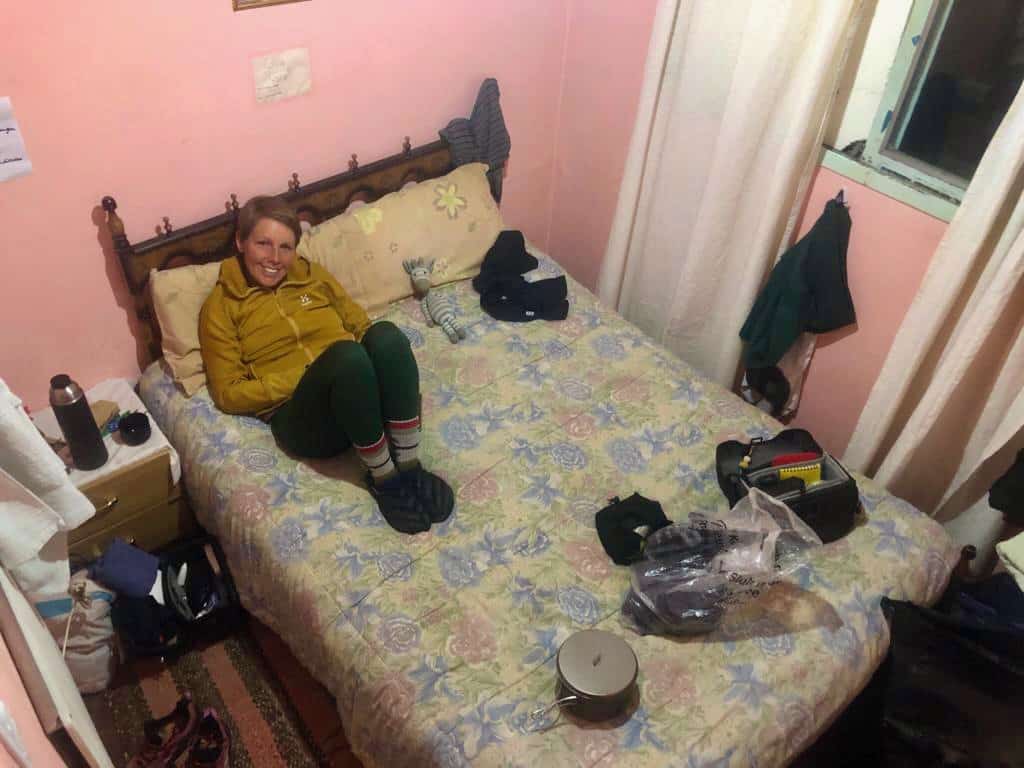
When we visit the small supermarket, it is rush hour. Saturday afternoon. There seem to be more people there than live in the village. In a few square meters, they navigate past each other with overflowing shopping carts. What is going on here? It turns out to be Chileans who live in the next town (50km) over the border. They come here to do their shopping because everything is two or three times as expensive. Products in closed packaging are allowed to cross the border without a problem. The hamster urge of the Chileans overcomes us and we too buy as much as fits in our bags. This is not a bad decision, as we will see when we look around the supermarket in Chile….
But, Chile, we won’t arrive there until the next blog.
For now, this seems like enough adventure in one report.
After all, in Chile, the Carretera Austral awaits us. A legendary and popular road for travelers. I won’t give away more, but since I am a bit behind with my writing, the next blog won’t be long.
Write you soon, from wet Chile!
